13.6: Tundra Biome
- Page ID
- 16156
\( \newcommand{\vecs}[1]{\overset { \scriptstyle \rightharpoonup} {\mathbf{#1}} } \)
\( \newcommand{\vecd}[1]{\overset{-\!-\!\rightharpoonup}{\vphantom{a}\smash {#1}}} \)
\( \newcommand{\dsum}{\displaystyle\sum\limits} \)
\( \newcommand{\dint}{\displaystyle\int\limits} \)
\( \newcommand{\dlim}{\displaystyle\lim\limits} \)
\( \newcommand{\id}{\mathrm{id}}\) \( \newcommand{\Span}{\mathrm{span}}\)
( \newcommand{\kernel}{\mathrm{null}\,}\) \( \newcommand{\range}{\mathrm{range}\,}\)
\( \newcommand{\RealPart}{\mathrm{Re}}\) \( \newcommand{\ImaginaryPart}{\mathrm{Im}}\)
\( \newcommand{\Argument}{\mathrm{Arg}}\) \( \newcommand{\norm}[1]{\| #1 \|}\)
\( \newcommand{\inner}[2]{\langle #1, #2 \rangle}\)
\( \newcommand{\Span}{\mathrm{span}}\)
\( \newcommand{\id}{\mathrm{id}}\)
\( \newcommand{\Span}{\mathrm{span}}\)
\( \newcommand{\kernel}{\mathrm{null}\,}\)
\( \newcommand{\range}{\mathrm{range}\,}\)
\( \newcommand{\RealPart}{\mathrm{Re}}\)
\( \newcommand{\ImaginaryPart}{\mathrm{Im}}\)
\( \newcommand{\Argument}{\mathrm{Arg}}\)
\( \newcommand{\norm}[1]{\| #1 \|}\)
\( \newcommand{\inner}[2]{\langle #1, #2 \rangle}\)
\( \newcommand{\Span}{\mathrm{span}}\) \( \newcommand{\AA}{\unicode[.8,0]{x212B}}\)
\( \newcommand{\vectorA}[1]{\vec{#1}} % arrow\)
\( \newcommand{\vectorAt}[1]{\vec{\text{#1}}} % arrow\)
\( \newcommand{\vectorB}[1]{\overset { \scriptstyle \rightharpoonup} {\mathbf{#1}} } \)
\( \newcommand{\vectorC}[1]{\textbf{#1}} \)
\( \newcommand{\vectorD}[1]{\overrightarrow{#1}} \)
\( \newcommand{\vectorDt}[1]{\overrightarrow{\text{#1}}} \)
\( \newcommand{\vectE}[1]{\overset{-\!-\!\rightharpoonup}{\vphantom{a}\smash{\mathbf {#1}}}} \)
\( \newcommand{\vecs}[1]{\overset { \scriptstyle \rightharpoonup} {\mathbf{#1}} } \)
\( \newcommand{\vecd}[1]{\overset{-\!-\!\rightharpoonup}{\vphantom{a}\smash {#1}}} \)
\(\newcommand{\avec}{\mathbf a}\) \(\newcommand{\bvec}{\mathbf b}\) \(\newcommand{\cvec}{\mathbf c}\) \(\newcommand{\dvec}{\mathbf d}\) \(\newcommand{\dtil}{\widetilde{\mathbf d}}\) \(\newcommand{\evec}{\mathbf e}\) \(\newcommand{\fvec}{\mathbf f}\) \(\newcommand{\nvec}{\mathbf n}\) \(\newcommand{\pvec}{\mathbf p}\) \(\newcommand{\qvec}{\mathbf q}\) \(\newcommand{\svec}{\mathbf s}\) \(\newcommand{\tvec}{\mathbf t}\) \(\newcommand{\uvec}{\mathbf u}\) \(\newcommand{\vvec}{\mathbf v}\) \(\newcommand{\wvec}{\mathbf w}\) \(\newcommand{\xvec}{\mathbf x}\) \(\newcommand{\yvec}{\mathbf y}\) \(\newcommand{\zvec}{\mathbf z}\) \(\newcommand{\rvec}{\mathbf r}\) \(\newcommand{\mvec}{\mathbf m}\) \(\newcommand{\zerovec}{\mathbf 0}\) \(\newcommand{\onevec}{\mathbf 1}\) \(\newcommand{\real}{\mathbb R}\) \(\newcommand{\twovec}[2]{\left[\begin{array}{r}#1 \\ #2 \end{array}\right]}\) \(\newcommand{\ctwovec}[2]{\left[\begin{array}{c}#1 \\ #2 \end{array}\right]}\) \(\newcommand{\threevec}[3]{\left[\begin{array}{r}#1 \\ #2 \\ #3 \end{array}\right]}\) \(\newcommand{\cthreevec}[3]{\left[\begin{array}{c}#1 \\ #2 \\ #3 \end{array}\right]}\) \(\newcommand{\fourvec}[4]{\left[\begin{array}{r}#1 \\ #2 \\ #3 \\ #4 \end{array}\right]}\) \(\newcommand{\cfourvec}[4]{\left[\begin{array}{c}#1 \\ #2 \\ #3 \\ #4 \end{array}\right]}\) \(\newcommand{\fivevec}[5]{\left[\begin{array}{r}#1 \\ #2 \\ #3 \\ #4 \\ #5 \\ \end{array}\right]}\) \(\newcommand{\cfivevec}[5]{\left[\begin{array}{c}#1 \\ #2 \\ #3 \\ #4 \\ #5 \\ \end{array}\right]}\) \(\newcommand{\mattwo}[4]{\left[\begin{array}{rr}#1 \amp #2 \\ #3 \amp #4 \\ \end{array}\right]}\) \(\newcommand{\laspan}[1]{\text{Span}\{#1\}}\) \(\newcommand{\bcal}{\cal B}\) \(\newcommand{\ccal}{\cal C}\) \(\newcommand{\scal}{\cal S}\) \(\newcommand{\wcal}{\cal W}\) \(\newcommand{\ecal}{\cal E}\) \(\newcommand{\coords}[2]{\left\{#1\right\}_{#2}}\) \(\newcommand{\gray}[1]{\color{gray}{#1}}\) \(\newcommand{\lgray}[1]{\color{lightgray}{#1}}\) \(\newcommand{\rank}{\operatorname{rank}}\) \(\newcommand{\row}{\text{Row}}\) \(\newcommand{\col}{\text{Col}}\) \(\renewcommand{\row}{\text{Row}}\) \(\newcommand{\nul}{\text{Nul}}\) \(\newcommand{\var}{\text{Var}}\) \(\newcommand{\corr}{\text{corr}}\) \(\newcommand{\len}[1]{\left|#1\right|}\) \(\newcommand{\bbar}{\overline{\bvec}}\) \(\newcommand{\bhat}{\widehat{\bvec}}\) \(\newcommand{\bperp}{\bvec^\perp}\) \(\newcommand{\xhat}{\widehat{\xvec}}\) \(\newcommand{\vhat}{\widehat{\vvec}}\) \(\newcommand{\uhat}{\widehat{\uvec}}\) \(\newcommand{\what}{\widehat{\wvec}}\) \(\newcommand{\Sighat}{\widehat{\Sigma}}\) \(\newcommand{\lt}{<}\) \(\newcommand{\gt}{>}\) \(\newcommand{\amp}{&}\) \(\definecolor{fillinmathshade}{gray}{0.9}\)The Arctic Tundra
We find the arctic tundra biome at high latitudes closely associated with the tundra climate. Notable areas of arctic tundra are found along the arctic coastal North America, Europe, Asia and Greenland. Short grasses, flowers, and grass-like sedges, along with covers of mosses and lichens are the dominate forms of vegetation in the tundra. Seasonal frost heave disrupts root systems preventing support for tall vegetation. The arctic tundra looks like a treeless plain, interrupted by patterned ground and an occasional tree in selected microenvironments.
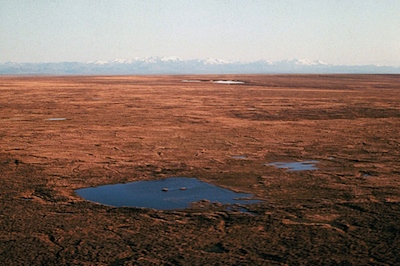
Pattern ground shown in Figure \(\PageIndex{1}\) is typical of the tundra landscape. Stone polygons, soil circles, stone or soil stripes and terraces are common to both arctic and alpine tundra. These features are created by thrusting action of repeated freezing and thawing of moist soil over a solid substrate like rock or permanently frozen ground. Polygonal patterns dominate flat surfaces. Vegetation is usually confined to the stable parts of the patterns.
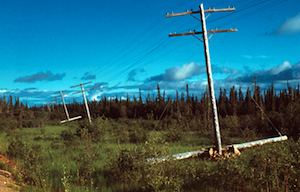
Permafrost is a common feature of the arctic tundra climate and biome. Permafrost refers to permanently frozen ground. Actually, the ground has two layers which freeze. A surface layer, called the active layer, thaws during the short "summer" and often subsides. Beneath the active layer is the inactive layer which stays frozen throughout the year. Permafrost creates a barrier to the root development. Larger trees can grow along better drained river valleys where the depth to permafrost is greater. The annual freezing and thawing disrupts root systems inhibiting the growth of very tall vegetation.
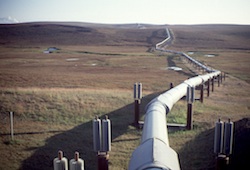
Permafrost creates an engineering nightmare for the construction of buildings and other structures. You can see in Figure \(\PageIndex{2}\) how telephone poles have been tilted from the heaving of the surface during freezing and thawing. Much concern for damage to the environment was raised over the construction of the Trans-Alaska Pipeline. The heated oil running though the pipeline is insulated from the cold permafrost where it runs underground. In places it zigzags over the surface on stilts that allow it to expand and contract.
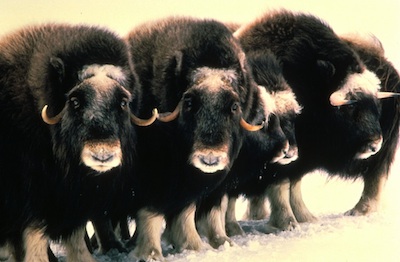
The Musk Oxen is a well-known inhabitant of the arctic tundra. A dense fur coat protects them from the severe climatic conditions in the tundra. Beneath is a dense fine undercoat that is fairly waterproof. Adults gather in a protective wall to keep the calves safe from predator attacks and severe storms. Musk oxen inhabited much of Eurasia and North America during the Ice Ages, but now survive only in parts of Greenland and northern Canada.
Video: Arctic National Wildlife Refuge (Courtesy USFWS)
The Alpine Tundra
The tundra biome is found at high elevations in mountainous terrain, as well. Many, if not all, the same features of the arctic tundra are found in the alpine tundra. Microclimate is an important control over the distribution of plant species as slope and exposure control the availability of light and moisture. The landscape is dotted with small cushion plants, lichens and mosses. Willows are found where moisture is abundant. Other factors like soil development, movement of soil by animals, and drainage determine vegetation community distribution.
Vegetation consists of low growing shrubs, cushion plants, small forbs exploding with colorful flowers and lush meadows of sedges and grasses. These plants cover gentle slopes and rock crevices. Rock surfaces are dotted with a cover of lichens and mosses. Most species are slow-growing perennials. Plants have been forced to adapt to such an extreme environment. Plant roots store nutrients and energy during poor growing periods. Roots make up ninety percent of some plants in the alpine tundra. Flowers often are large on tundra plants. Other parts of the plant are small to save energy and reducing exposure to wind. Some plants have waxy coatings or hairs thus losing minimal heat and water to the wind. The location of plant communities is correlated with the duration of snow cover. While snow is blown free from exposed sites, it accumulates in the lee of obstructions and in depressions. Community location is also related to soil, drainage, and movement of soil by burrowing animals, and frost action throughout much of the alpine tundra. Dense willow thickets often occupy moist depressions on the lee side of ridges. A deep cover of snow during the winter protects buds from the wind and freezing temperatures. These are the tallest perennials growing above the krummholz of the ecotone.

Fell fields are colorful rock gardens exposed to the rigors of the wind. Wind removes snow throughout the season subjecting the plants to desiccation. Low-lying mats and cushion plants nestle against the rocky surface.
The climate of the tundra is exceedingly harsh. Annual precipitation is around 40 inches, but effective precipitation is far below that amount. Snow remains as permanent snow fields at some sites. Wind speeds can exceed 100 mph and mean annual temperature is below freezing. Diurnal temperature ranges are small because the air is mixed by the constant winds. The frost free season is approximately 1 1/2 months.
Soils are quite variable in the tundra. Thin soils lie in the valleys scoured by glaciers. Mature residual soils are found on unglaciated ridges and between rocks brought to the surface by frost heave to form polygons. Soil ice is found in all soils in winter, and soil temperatures are low enough to form patches of permafrost.
Solifluction terraces are a common landscape feature of the alpine tundra. Late lying snow patches keep conditions moist to permit willow growth. Reaching a few feet high, willows are covered in snow to protect the over-wintering buds. Willows are the tallest of any species in the alpine tundra.
The plant communities mentioned above are considered climax communities mainly because they change so slowly. Communities are often disturbed by small burrowing animals like the pocket gopher that churn up the soil and eat plant roots, or voles which can devastate above - ground biomass. Recovery after disturbance proceeds exceedingly slow, slower than any other mountain ecosystem.
In comparison to other portions of the Earth, the Arctic is undergoing the most rapid change in temperature as a result of climate change. Recent warming has had a drastic affect on surface processes, the well-being of animal species, and the geography of plants. The dramatic warming in Alaska has increased the growing degree days for agriculture and forestry by twenty percent. Boreal forests are expanding their range at a rate of 100 to 150 km per oC increase in temperature. With warmer temperatures comes longer and deeper thaw cycles resulting in thermokarst and wetlands in the forest. The annual area burned in northwestern North America has doubled over the last twenty years and Eurasian forests have experienced similar trends.
Warming temperature in the Arctic is thawing permafrost making coasts and slopes along streams more susceptible to erosion and mass movement. Thaw slumps, sliding masses of soft soil, slide into pristine streams turning them muddy and smothering fish eggs waiting to hatch from gravels that line river beds. Coastal erosion results in a loss of land habitat for those living on the North Slope, a trend that is predicted to continue into the future.
A Pew Center review of current research indicates that nearly half of known wild species have been affected by global warming. For example, polar bear populations are on the decline as arctic sea ice thins making for precarious hunting conditions. Polar bears prowl the ice floes in search of food, notably seals. These white giants capture their prey by waiting for seals to appear in air holes in the ice. Packing on fat from rich seal meat enables them to survive when the ice melts making prey harder to find.
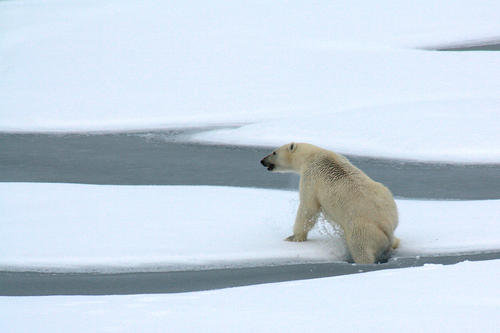
The warming oceans and melting sea ice have shortened polar bear access to food. In Canada's West Hudson Bay, sea ice is breaking up three weeks earlier as a result of changing climate conditions. Polar bear populations are down twenty percent in the last ten years as fewer cubs are born or make it to adulthood. Ice pack break up leaves polar bears stranded farther from land, sometimes drowning from trying to swim longer distances. In the northern part of Alaska polar bears are moving inland as the Arctic sea ice coverage shrinks.
Video: "Melting Ice Could Erode Way of Life for Alaska's North Slope" (Courtesy PBS Newshour)New novel climates will appear while other climates may disappear with future global warming. The Arctic is forecast to undergo some of the greatest changes in climate patterns. Climate models indicate that the tundra will be retreat to northern coasts and islands of the Arctic Ocean. Tundra vegetation will be replaced by boreal forests and shrubs.


